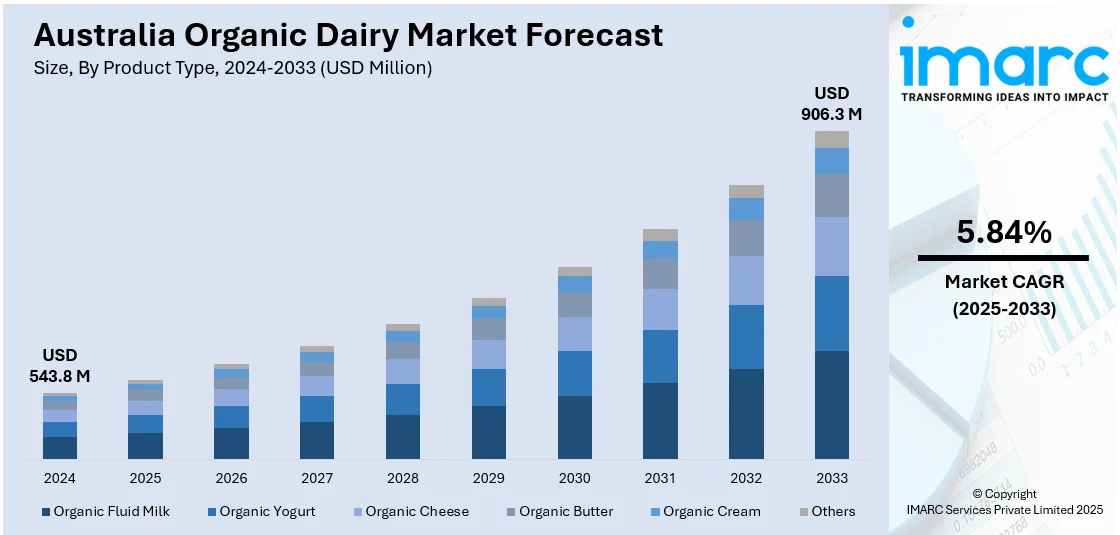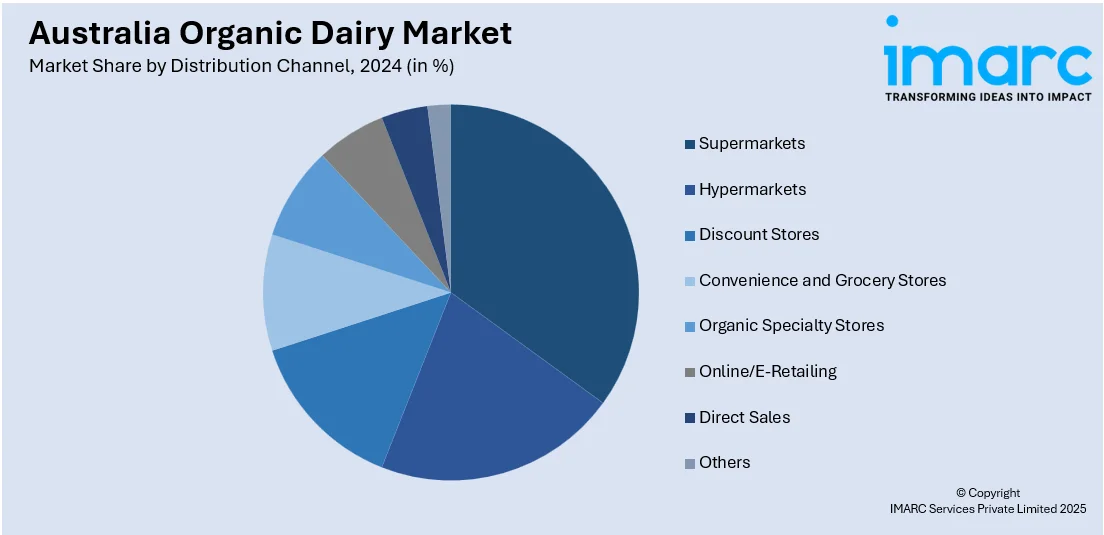
Australia Organic Dairy Market Size, Share, Trends and Forecast by Product Type, Packaging Type, Distribution Channel, and Region, 2025-2033
Australia Organic Dairy Market Overview:
The Australia organic dairy market size reached USD 543.8 Million in 2024. Looking forward, IMARC Group expects the market to reach USD 906.3 Million by 2033, exhibiting a growth rate (CAGR) of 5.84% during 2025-2033. The market is driven by rising health consciousness, growing lactose intolerance, increasing disposable incomes, expanding environmental sustainability concerns, strong government support for organic farming, expanding retail availability, and surging demand for clean-label, chemical-free dairy products.
|
Report Attribute
|
Key Statistics
|
|---|---|
|
Base Year
|
2024
|
|
Forecast Years
|
2025-2033
|
|
Historical Years
|
2019-2024
|
| Market Size in 2024 | USD 543.8 Million |
| Market Forecast in 2033 | USD 906.3 Million |
| Market Growth Rate 2025-2033 | 5.84% |
Australia Organic Dairy Market Trends:
Diversification of Organic Dairy Product Offerings
The Australia organic dairy market share is expanding, driven by product diversification, extending past traditional dairy items, including milk and butter. In line with this, manufacturers are introducing new items such as probiotic-rich yogurts while adding organic cream-based desserts and infant formulas to serve the different needs of consumers and age groups. For instance, in April 2024, Else Nutrition launched a plant-based, soy-free infant formula in Australia, supporting the organic dairy market's diversification by offering allergen-friendly, nutritious options for health-conscious parents and expanding choices beyond traditional dairy categories. Moreover, health-conscious consumers boost this market trend because they seek more convenient products with nutritional value and numerous choices. People are also following flexitarian diets, wherein the increased understanding of gut health is encouraging the creation of fortified and functional dairy products. Furthermore, brands are leveraging organic certification mainstreaming to implement premiumization along with value-added benefits, which is enhancing the Australia organic dairy market outlook and consumer engagement.

To get more information on this market, Request Sample
Emphasis on Sustainable and Ethical Farming Practices
The organic dairy business in Australia is significantly developing its growth model based on sustainability principles. In addition to this, modern consumers check production methods carefully to purchase products from brands that demonstrate animal welfare standards, regenerative farming, and low-carbon footprint efforts. Concurrently, the Australian dairy farms now incorporate rotational grazing and solar energy use along with water-saving measures and compost-based soil management into their operations. For example, in March 2025, Warakirri Asset Management further advanced this movement by launching a A$500 million fund to invest in sustainable dairy farming, thereby boosting the organic sector through support for low-carbon and environmentally responsible practices. Besides this, these initiatives follow both organic certification requirements while fulfilling the environmental concerns of contemporary buyers. The sustainable attributes printed on packaging and menu items by foodservice providers and retailers further motivate customers to choose certain products. Apart from this, organic dairy companies are implementing sustainable practices because they have established themselves as essential factors for building trust and securing market leadership as climate transparency rises in importance, thereby driving the Australia organic dairy market growth.
Australia Organic Dairy Market Segmentation:
IMARC Group provides an analysis of the key trends in each segment of the market, along with forecasts at the region level for 2025-2033. Our report has categorized the market based on product type, packaging type, and distribution channel.
Product Type Insights:
- Organic Fluid Milk
- Organic Yogurt
- Organic Cheese
- Organic Butter
- Organic Cream
- Others
The report has provided a detailed breakup and analysis of the market based on the product type. This includes organic fluid milk, organic yogurt, organic cheese, organic butter, organic cream, and others.
Packaging Type Insights:
- Pouches
- Tetra-packs
- Bottles
- Cans
- Others
A detailed breakup and analysis of the market based on the packaging type have also been provided in the report. This includes pouches, tetra-packs, bottles, cans, and others.
Distribution Channel Insights:

- Supermarkets
- Hypermarkets
- Discount Stores
- Convenience and Grocery Stores
- Organic Specialty Stores
- Online/E-Retailing
- Direct Sales
- Others
The report has provided a detailed breakup and analysis of the market based on the distribution channel. This includes supermarkets, hypermarkets, discount stores, convenience and grocery stores, organic specialty stores, online/e-retailing, direct sales, and others.
Regional Insights:
- Australia Capital & New South Wales
- Victoria & Tasmania
- Queensland
- Northern Territory & Southern Australia
- Western Australia
The report has also provided a comprehensive analysis of all the major regional markets, which include Australia Capital & New South Wales, Victoria & Tasmania, Queensland, Northern Territory & Southern Australia, and Western Australia.
Competitive Landscape:
The market research report has also provided a comprehensive analysis of the competitive landscape. Competitive analysis such as market structure, key player positioning, top winning strategies, competitive dashboard, and company evaluation quadrant has been covered in the report. Also, detailed profiles of all major companies have been provided.
Australia Organic Dairy Market News:
- In November 2024, NOVUS introduced advanced nutritional feed solutions to dairy farmers in Australia and New Zealand, focusing on improving milk yields and animal welfare. This initiative supports sustainable farming practices and enhances dairy production efficiency.
- In September 2024, Australian Dairy Nutritionals secured a $2.13 million strategic placement and entered an exclusive supply agreement with a key partner in China, aiming to expand its presence in the world's largest infant formula market. This move is expected to enhance the company's export capabilities and market reach.
Australia Organic Dairy Market Report Coverage:
| Report Features | Details |
|---|---|
| Base Year of the Analysis | 2024 |
| Historical Period | 2019-2024 |
| Forecast Period | 2025-2033 |
| Units | Million USD |
| Scope of the Report |
Exploration of Historical Trends and Market Outlook, Industry Catalysts and Challenges, Segment-Wise Historical and Future Market Assessment:
|
| Product Types Covered | Organic Fluid Milk, Organic Yogurt, Organic Cheese, Organic Butter, Organic Cream, Others |
| Packaging Types Covered | Pouches, Tetra-Packs, Bottles, Cans, Others |
| Distribution Channels Covered | Supermarkets, Hypermarkets, Discount Stores, Convenience and Grocery Stores, Organic Specialty Stores, Online/E-Retailing, Direct Sales, Others |
| Regions Covered | Australia Capital & New South Wales, Victoria & Tasmania, Queensland, Northern Territory & Southern Australia, Western Australia |
| Customization Scope | 10% Free Customization |
| Post-Sale Analyst Support | 10-12 Weeks |
| Delivery Format | PDF and Excel through Email (We can also provide the editable version of the report in PPT/Word format on special request) |
Key Questions Answered in This Report:
- How has the Australia organic dairy market performed so far and how will it perform in the coming years?
- What is the breakup of the Australia organic dairy market on the basis of product type?
- What is the breakup of the Australia organic dairy market on the basis of packaging type?
- What is the breakup of the Australia organic dairy market on the basis of distribution channel?
- What is the breakup of the Australia organic dairy market on the basis of region?
- What are the various stages in the value chain of the Australia organic dairy market?
- What are the key driving factors and challenges in the Australia organic dairy?
- What is the structure of the Australia organic dairy market and who are the key players?
- What is the degree of competition in the Australia organic dairy market?
Key Benefits for Stakeholders:
- IMARC’s industry report offers a comprehensive quantitative analysis of various market segments, historical and current market trends, market forecasts, and dynamics of the Australia organic dairy market from 2019-2033.
- The research report provides the latest information on the market drivers, challenges, and opportunities in the Australia organic dairy market.
- Porter's five forces analysis assist stakeholders in assessing the impact of new entrants, competitive rivalry, supplier power, buyer power, and the threat of substitution. It helps stakeholders to analyze the level of competition within the Australia organic dairy industry and its attractiveness.
- Competitive landscape allows stakeholders to understand their competitive environment and provides an insight into the current positions of key players in the market.
Need more help?
- Speak to our experienced analysts for insights on the current market scenarios.
- Include additional segments and countries to customize the report as per your requirement.
- Gain an unparalleled competitive advantage in your domain by understanding how to utilize the report and positively impacting your operations and revenue.
- For further assistance, please connect with our analysts.
 Request Customization
Request Customization
 Speak to an Analyst
Speak to an Analyst
 Request Brochure
Request Brochure
 Inquire Before Buying
Inquire Before Buying




.webp)




.webp)












